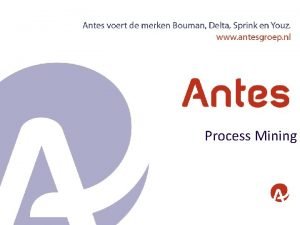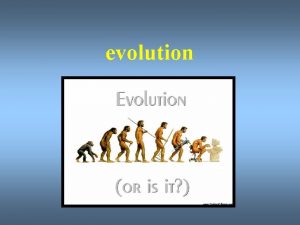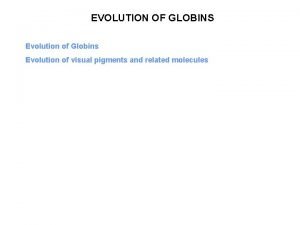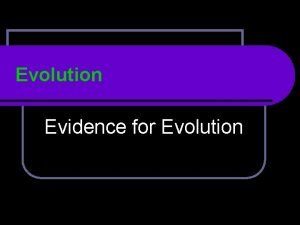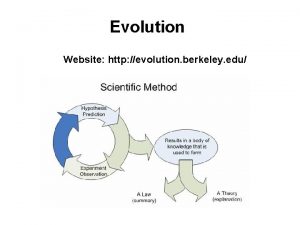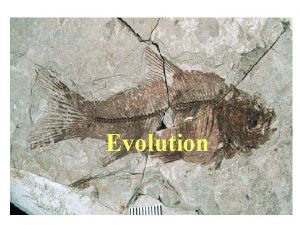AuditFocused Process Mining The Evolution of Process Mining











































- Slides: 43

Audit-Focused Process Mining: The Evolution of Process Mining and Internal Control Abdulrahman Alrefai Dissertation Committee: Miklos Vasarhelyi (Chair) Helen Brown-Liburd Hussein Issa Rajendra Srivastava

Optional Presentation Title What is Process Mining? Analyze the event log data that exists in the information systems of a company and use that to visualize and understand what is actually happening in the company’s processes and how they are executed in real life Unit Name

Optional Presentation Title Why Process Mining? • Digitization of business processes adds complexity, due to the amount of processes that occur simultaneously or with various lags (Kogan et al. 2010) • This increases the inability of conducting business in the ideal process design (van der Aalst 2010) • The difficulty in understanding and evaluating the internal control environment in today’s business processes can be facilitated by the utilization of process mining techniques (Jans et al. 2014) • Process mining can address the problem that most internal control experts face, which is having very limited information about what is actually happening in the business processes (Caron and Vantheinen 2012). Unit Name

Optional Presentation Title Motivation • Auditors need to obtain an understanding of internal controls over financial reporting and performing analytical procedures (AS 12) • Auditors conduct “walkthroughs” N I M – inquiry of appropriate personnel – observation of the company's operations – inspection of relevant documentation S • G IN S E Technology allows for different tools to validate information C about companies and their business processes. O R P Unit Name

Optional Presentation Title Dissertation Focus & Overall Contribution • This dissertation is an attempt to demonstrate the application of process mining in internal controls and its evolution • Demonstrate how process mining can address issues auditors face in today’s business environment, and how the future of process mining is envisioned Three essays: 1. The Application of Process Mining in Internal Control Risk Assessment 2. Process Instances Risk Prioritization 3. Continuous Process Monitoring Unit Name

The Application of Process Mining in Internal Control Risk Assessment Essay 1

Optional Presentation Title The Issue • SOX section 404 requires companies to establish internal controls for financial reporting and assess them via auditors to ensure their effectiveness • Auditors routinely fail to detect material weaknesses prior to a restatement Reason: • Auditors inaccurately assess control risk by misclassifying the severity of identified internal control deficiencies due to complexity in judging the materiality and likelihood of potential related errors (Aobdia et al. 2016) Unit Name

Optional Presentation Title Motivation • Large number of transactions being executed on a daily basis • To get any real comfort over the operating effectiveness of an internal control procedure is to test every instance of it running • Most controls are now evidenced somewhere in an organization’s computer systems • Process mining can be used to detect violations of controls • Exceptions can be used not only for investigative purposes, but also to assess control risk Unit Name

Optional Presentation Title Contribution • Develop a framework to assist auditors in assessing and issuing an opinion on the effectiveness of the internal controls system for an organization • Use process mining to formalize the measurement of controls by analyzing business workflows and identifying exceptions of transactions • Showcase how process mining can be used as a tool to identify deficiencies in the internal control system and proposes a framework that auditors can use to quantify and objectively assess control risk Unit Name

Optional Presentation Title Methodology • Any business process consists of many different controls implemented to mitigate the risk of fraudulent activities and unintentional errors, to insure that the financial statements are represented fairly • Auditors need to apply a two-part procedure when evaluating a business process: – check if controls are already implemented – evaluate and test if those controls are operating effectively Unit Name

Optional Presentation Title Control a Control b Control n Process Mining Techniques &/ or Risks Discovery & Visualization Conformance Checking Mine & Analyze Rules Event Log Business Process Information System Design of Internal Control System Actual Process Flow Model Operation of Internal Control System Rules & Controls Violations Frequency Risk Assessment Unit Name Impact

Optional Presentation Title Variant # 1 2 Variant Frequency Sequence 4 Create PO —> Sign —> GR —> Release % Mean Min Max 927 21. 71 21. 3 d 1. 5 h 1. 08 y 860 20. 14 41. 85 29. 2 d 0. 3 h 1. 13 y 160 3. 75 45. 60 27. 0 d 4. 8 h 0. 98 y 115 2. 69 48. 29 32. 1 d 17. 9 h 1. 02 y 101 2. 37 50. 66 15. 5 d 16. 0 h 0. 77 y 70 1. 64 52. 30 24. 2 d 1. 1 h 0. 79 y 50 1. 17 53. 47 199. 5 d 9. 1 d 1. 13 y Create PO —> Sign —> GR —> IR —> Release Create PO —> Sign —> Sign—> GR —> IR —> Release 7 % Create PO —> Sign —> GR —> IR —> Release Create PO —> Sign —> GR —> Release 6 Throughput Time Create PO —> Sign —> GR —> IR —> Release 3 5 # Cum. Total Create PO —> Sign —> GR —> IR Unit Name —> Release

Optional Presentation Title Evaluation Of The Procurement Process Risks & Controls Model Risk Control Violation Frequency % Impact % Inappropriate purchase order A sign activity must be performed at least once 0 0% $0 0% Inappropriate purchase order The value of a purchase order must be specified 69 1% $1, 251, 516. 22 1% 0 0% $0 0% Inappropriate purchase order The value of a purchase order may not change after a sign activity has been performed Incorrect invoice approval A purchase order activity must be started before date of invoice receipt 6 0. 1% $241, 594. 87 0. 3% Inappropriate access A person must not perform all activities of the P 2 P process 16 0. 4% $42, 853. 57 0. 4% 61 1% $989, 351. 47 1% 139 3% $10, 584, 025. 10 10% 27 1% $683, 955. 64 1% 32 0. 7% $844, 426. 38 0. 5% 1310 31% $32, 932, 037. 54 33% 0 0% $0 0% 480 11% $7, 451, 027. 95 7% 36 1% $763, 489. 34 1% Inappropriate access Invoice entry error Goods received not matching valid purchase Payment error Unit Name Suboptimal task allocation A good receipt activity must be performed during regular business hours A person must perform a release activity after time T = timestamp of goods receipt event A release activity must be performed by a member of senior staff An invoice pay activity cannot be duplicated for the same purchase order The values of Purchase order, goods receipt, and invoice receipt must match before the corresponding invoice can be paid The value of a purchase order may not change after a sign activity has been performed If a goods receipt activity is performed then an invoice receipt activity must be performed A good receipt activity must not be performed by a member of senior

Optional Presentation Title Conclusion • Demonstrate the use process mining to test internal controls to provide an overall risk assessment of the internal control system for a business process • Provide auditors with a way to embrace a more formal internal control risk assessment process with quantitative outcomes • Limitation: Not all types of controls were tested Unit Name

Process Instances Risk Prioritization Essay 2

Optional Presentation Title Introduction • Complex ERP systems capture thousands if not millions of transactions on a daily basis • It is impractical to analyze this huge amount of data using traditional and periodic techniques • The use of advanced techniques result in generating an overwhelming amount of exceptions (Alles et al. 2006; Debreceny et al. 2003) • Process-aware information systems allow for dynamic process and service changes leads to large number of process model variants (Li et al. 2008) • Process mining analysis results into a large number of anomalies or exceptions that can be overwhelming Unit Name

Optional Presentation Title Contribution • Proposing a methodology that provides auditors with guidance as to which notable transactions need further investigation based on a risk score • The identification and prioritization of such risky process instances helps with the information overload problem that entails population testing • Provide a solution to one of the challenges auditors face when applying process mining in their audit engagement The large number of false positive variants Unit Name

Optional Presentation Title Contribution • Provide guidance on the use of process mining in conjunction with existing analytical procedures to: – allow auditors to focus on process instances that are likely to be considered high-risk – reduce the risk of failing to detect material misstatement – enhance audit effectiveness Unit Name

Optional Presentation Title Methodology The methodology that is used to objectively score the riskiness of transactions is based on: • Process mining with filters – Filters mapped to the risks and controls for the targeted business process – Each filter is given a weight based on importance and relevance using auditor judgment • Other analytical procedures to identify exceptional transactions from the notable subpopulation • Exceptional transactions will be scored based on the number of violations for each transaction along with the transactional value. • Transactions will be ranked based on their risk score Unit Name

Optional Presentation Title Information System Data Preparation Event Log Data Audit Objectives & Risk Assessment Data collection and preparation Process understanding and risk factors identification Process Discovery & Understanding Variant Examination & Risk Factors Identification Process mining application Develop Process. Related Filters Feedback Notable Process Instances Unit Name Develop Other Process Filters Existing analytical procedures application Feedback Exceptional Process Instances Prioritization Method Prioritized Exceptional Process Instances Prioritization of exceptional process instances

Optional Presentation Title Risk Score Formula • Unit Name

Optional Presentation Title Data • Data Preparation: – 128 process instances with 21 variants that lacked both GR and IR activities and had a PO value of $0 – Days of the week were added to the event log based on the timestamp in order to apply related filters Events 71, 203 Beginning Process Instances (P. I. ) 4, 270 Removed Incomplete P. I. (128) Final Number of P. I. 4, 142 Variants 1, 040 Unit Name

Optional Presentation Title Application & Results (Process Mining) Risk Factor Category Missing Key Activity Sub-Category Filter Risk Level Process Instance Variants Missing GR activity Any process instance missing GR High 94 22 Missing IR activity Any process instance missing IR High 480 108 Missing Release activity Any process instance missing Release High 409 336 Unusual start for a PO Process instances starting with IR Medium 6 3 Payments before all goods are received Payment before GR High 176 155 Low 20 14 Low 163 142 High 36 33 Medium 551 296 Problematic Order Process instances ending with Create Ending with Create PO PO Ending with GR Process instances ending with GR The employee who created the order Segregation of Duty SOD violation also released the order Process instances with activities Weekend Activity Unit Name Unauthorized weekend activity happening on weekends 1, 346 unique notable process instances

Optional Presentation Title Application & Results (Analytical Procedures) Risk Factor Category Sub-Category Filter Risk Level Process Instance High 252 High 18 High 622 High 652 High 353 Any process instance missing PO value or Missing PO value equals $0 Any process instance missing quantity value Missing Values Missing PO quantity for PO Missing Invoice Any process instance missing invoice value Any process instance with PO and GR Unmatched PO and goods values that do not match 2 -Way Match Violation Any process instance with PO and GR Unmatched PO and goods quantities that do not match Any process instance with GR and IR values Unmatched goods and invoice values that do not match Unit Name 814 unique exceptional process instances (457 > $5, 000)

Optional Presentation Title 3 3 2 3 1 1 3 2 3 3 quantities Unmatched GR & IR Unmatched PO & GR Missing invoice Missing PO quantity Missing PO value Weekend SOD violation GR ending Create PO ending Pay before GR Unusual start Missing IR Process Instance Missing Release Application & Results (Prioritization) 3 3 Violation Score Monetary Value Risk Score 88702 X X X 11 $11, 579, 094 127 88814 X X X X 14 $7, 882, 137 110 87646 X X X X 11 $3, 137, 867 35 87639 X X X X 11 $2, 659, 998 29 89106 X X X 8 $3, 120, 400 25 89465 X X X 10 $1, 507, 415 15 88749 X X X 10 $1, 179, 759 12 89503 X X X X X 13 $877, 638 11 87640 X X X 14 $729, 189 10 88816 X X X X 12 $686, 957 8 Unit Name

Optional Presentation Title Framework Comparison Process Instances Risk Prioritization Chiu et al. (2018) Framework Count Percentage 1, 346 32. 5% 3, 918 42. 6% Exceptional Process Instances 814 19. 7% -- -- Threshold 457 11. 0% 1, 227 13. 4% Notable Process Instances Unit Name

Optional Presentation Title Conclusion • The aim and contribution of this study is to provide auditors with guidance on the use of process mining in conjunction with existing analytical procedures to identify exceptional transactions that would require further investigation – – Focus on process instances that are likely to be considered high-risk Reduce the risk of failing to detect material misstatement Enhance audit effectiveness. Help with the information overload problem that entails population testing • Limitation: Depends on the filters developed in the different stages of the framework and the weight given to each filter • Future Work: – Switch the application of process mining and other analytical procedures. – Implement the risk score methodology found in this study to a continuous Unit Name process mining solution to allow or block transactions based on their risk score

Continuous Process Monitoring Essay 3

Optional Presentation Title Motivation • Reduce the time delay between the occurrence and the analysis of business operations related events increases the information value • Do it automatically and continuously • Today’s business environment allows for the adoption of continuous analytical monitoring-based assurance because of the electronization of firms through the widespread use of ERP systems (Vasarhelyi et al. 2004) Unit Name

Optional Presentation Title Contribution • Develop a novel approach for assurance that combines the advantages of continuous monitoring with those of process mining • Actively detect and investigate deviations and exceptions as they occur along the transaction process • The use of process mining on a continuous basis to monitor business processes and provide assurance hasn’t been found in the auditing literature Unit Name

Optional Presentation Title Methodology • Continuous Monitoring with Process Mining techniques – Based on a monitoring control layer – Rule-based process mining • Implementing this methodology requires two key components: – IT structure that facilitates data gathering – Analytic monitoring methodology to support continuous monitoring (Vasarhelyi et al. 2004) Unit Name

Optional Presentation Title Export Utility for Automatic Log Generation Information System Process Understanding & Discovery Automated Event Log Refine Rules Continuous Monitoring Layer Rules & Controls Violation Business Process Violation Log No Yes Allow Unit Name Complete Transaction Block

Optional Presentation Title Process Understanding & Discovery Past • Prior to implementation, understand how transaction are being Activities conducted Event • Examine all past transactions to establish the path for that Database Log process Process Flow Final Process Yes Acceptable? • Model past transactions using the event log to be used as a Modeling Flow Model baseline for required process flows Refine Process Flow Unit Name No

Optional Presentation Title Automatic Log Generation • Automatically generate the event log and event streams to be used as an input for the continuous monitoring layer • To automate log extraction, there needs to be an export utility on top of the system. – This can be an SAP Plug-in. – The plug-in has to be engineered for that system. • The export utility extracts the required information as the activities are being performed for a transaction, and join them to automatically generate the log • Ensures continuous flow of data Unit Name

Optional Presentation Title Rule Pattern Relevant Rules Identification An activity of type a 1 must be performed at least once Example from the P 2 P process A sign activity must be performed at least once If an activity of type a 1 is performed then an activity of type a 2 must be If a goods receipt activity is performed then an invoice receipt activity must be • Rules have to be defined to compare each activity throughout performed a transaction against it An activity of type a 1 must be started/ completed before/ after/on t time units A Sign activity must be started before date of goods receipt performed A person must not perform both activities for role r 1 and activities for role r 2 A person must not sign and release the same purchase order • Cover many different risk scenarios that a company might purchase order face A person must not perform both an activity of type a 1 and an activity of type a 2 A person must not sign and perform a good receipt activity for the same A person must not perform all activities of the activity type set s. A A person must not perform all activities of the P 2 P process An activity of type a 1 must be performed under μ A good receipt activity must be performed during regular business hours An activity of type a 1 must be performed by a member of role r 1 A release activity must be performed by a member of senior staff An activity of type a 1 must not be performed by a member of role r 1 A good receipt activity must not be performed by a member of senior staff The value for event data type a 1 must be specified The value of a purchase order must be specified • Rules need to be comprehensive in mitigating risks associated A person must perform an activity of type a 1 before/at/after time T (with T A person must perform a release activity after time T = timestamp of goods with management assertions and fraudulent activities referring to time/activity/event) receipt event The value of event data type a 1 is equal to the value of event data type a 2 and The values of Purchase order, goods receipt, and invoice receipt must match a 3 before the corresponding invoice can be paid Unit Name The value of data type a 1 may not change before/at/ after a completion of The value of a purchase order may not change after a sign activity has been activity a 2 performed

Optional Presentation Title Continuous Monitoring Layer • Abstracted layer placed on top of the business process • The CM layer is based on an independent system called the monitoring and control layer (Vasarhelyi et al. 2004) • The layer stores the “ideal” model for the business process and the rules already defined • Test each transaction against prescribed model and defined rules to catch violations Unit Name

Optional Presentation Title Case # 89501 Activity Originator Timestamp Value PO Create PO P 1 02/12/2016 14: 17: 04 600. 00 Sign P 1 02/12/2016 14: 17: 05 600. 00 Value GR Value Pay Sign P 2 07: 42: 31 02/16/2016 600. 00 Duplicate payment suspicion GR P 3 02/16/2016 09: 44: 20 600. 00 600 IR P 3 15: 16: 37 02/17/2016 600. 00 IR P 3 15: 17: 49 02/17/2016 600. 00 Release Unit Name P 4 02/18/2016 07: 01: 17 600. 00

Optional Presentation Title Case # 90027 Activity Originator Timestamp Value PO Value GR Value Pay IR P 1 14: 40: 45 04/01/2016 17783. 75 17, 784 17, 783. 75 Create PO P 2 10: 28: 34 04/05/2016 17783. 75 Sign P 3 14: 56: 13 04/07/2016 17783. 75 GR P 1 04/08/2016 08: 40: 06 17783. 75 Release Unit Name P 4 04/08/2016 15: 03: 20 17783. 75 6 cases where the first activity is an IR not a PO creation 17, 784

Optional Presentation Title Case # 89554 Activity Originator Timestamp Value PO Create PO P 1 12: 19: 01 02/19/2016 15. 71 Create PO P 1 12: 19: 01 02/19/2016 49. 00 Sign P 1 12: 19: 02 02/19/2016 15. 71 Sign P 1 12: 19: 02 02/19/2016 49. 00 GR P 1 02/19/2016 12: 20: 27 15. 71 GR P 1 02/19/2016 12: 20: 27 49. 00 3 way match violation IR P 1 02/24/2016 11: 51: 45 15. 71 21, 783. 05 IR P 1 02/24/2016 11: 51: 45 49. 00 21, 783. 05 Release P 2 02/24/2016 14: 26: 28 15. 71 P 2 02/24/2016 14: 26: 28 49. 00 Unit Name Release Value GR Value Pay Segregation of duty violation

Optional Presentation Title Conclusion • Instead of reacting after the violations have long occurred, this solution allows auditors to actively detect and investigate deviations and exceptions as they occur along the transaction process by continuously monitoring business process controls and testing transactions • Demonstrate the use of process mining as a preventative approach rather than detective (rarely found in the auditing literature) Unit Name

Conclusion

Optional Presentation Title Conclusion • Essay 1 – Contributed by providing auditors with a way to objectively measure the effectiveness of internal controls and risk assessment – Are controls are implemented, to what degree, and what’s the impact? • Essay 2 – Contributed by providing auditors with guidance on the use of process mining in conjunction with existing analytical procedures to identify exceptional transactions that would require further investigation – The identification and prioritization of high-risk process instances help with the information overload problem that entails process mining • Essay 3 – Contributed by providing a methodology to actively detect and investigate deviations and exceptions as they occur along the transaction process – Demonstrate the use of process mining as a preventative approach Unit Name rather than detective (rarely found in the auditing literature)

Optional Presentation Title Thank You Unit Name
 Strip mining vs open pit mining
Strip mining vs open pit mining Mineral resources and mining chapter 13
Mineral resources and mining chapter 13 Difference between strip mining and open pit mining
Difference between strip mining and open pit mining Web text mining
Web text mining Mining multimedia databases
Mining multimedia databases Mining complex data types
Mining complex data types Hát kết hợp bộ gõ cơ thể
Hát kết hợp bộ gõ cơ thể Frameset trong html5
Frameset trong html5 Bổ thể
Bổ thể Tỉ lệ cơ thể trẻ em
Tỉ lệ cơ thể trẻ em Gấu đi như thế nào
Gấu đi như thế nào Tư thế worm breton là gì
Tư thế worm breton là gì Bài hát chúa yêu trần thế alleluia
Bài hát chúa yêu trần thế alleluia Môn thể thao bắt đầu bằng từ đua
Môn thể thao bắt đầu bằng từ đua Thế nào là hệ số cao nhất
Thế nào là hệ số cao nhất Các châu lục và đại dương trên thế giới
Các châu lục và đại dương trên thế giới Công của trọng lực
Công của trọng lực Trời xanh đây là của chúng ta thể thơ
Trời xanh đây là của chúng ta thể thơ Cách giải mật thư tọa độ
Cách giải mật thư tọa độ 101012 bằng
101012 bằng độ dài liên kết
độ dài liên kết Các châu lục và đại dương trên thế giới
Các châu lục và đại dương trên thế giới Thơ thất ngôn tứ tuyệt đường luật
Thơ thất ngôn tứ tuyệt đường luật Quá trình desamine hóa có thể tạo ra
Quá trình desamine hóa có thể tạo ra Một số thể thơ truyền thống
Một số thể thơ truyền thống Bàn tay mà dây bẩn
Bàn tay mà dây bẩn Vẽ hình chiếu vuông góc của vật thể sau
Vẽ hình chiếu vuông góc của vật thể sau Nguyên nhân của sự mỏi cơ sinh 8
Nguyên nhân của sự mỏi cơ sinh 8 đặc điểm cơ thể của người tối cổ
đặc điểm cơ thể của người tối cổ V cc
V cc Vẽ hình chiếu đứng bằng cạnh của vật thể
Vẽ hình chiếu đứng bằng cạnh của vật thể Phối cảnh
Phối cảnh Thẻ vin
Thẻ vin đại từ thay thế
đại từ thay thế điện thế nghỉ
điện thế nghỉ Tư thế ngồi viết
Tư thế ngồi viết Diễn thế sinh thái là
Diễn thế sinh thái là Các loại đột biến cấu trúc nhiễm sắc thể
Các loại đột biến cấu trúc nhiễm sắc thể Số nguyên là gì
Số nguyên là gì Tư thế ngồi viết
Tư thế ngồi viết Lời thề hippocrates
Lời thề hippocrates Thiếu nhi thế giới liên hoan
Thiếu nhi thế giới liên hoan ưu thế lai là gì
ưu thế lai là gì Sự nuôi và dạy con của hươu
Sự nuôi và dạy con của hươu
















































